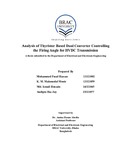Analysis of Thyristor based dual converter controlling the firing angle for HVDC transmission
Abstract
Electricity is one of the most reliable energy sources because it can be converted into any form of energy and can easily be transmitted from one place to another. For transmission purpose we use Alternating current because producing the AC current is much more efficient than DC. The problem occurs when we want to transmit the electric energy to long distance AC current causes more transmission loss then DC current. That is why, for a long transmission line we use HVDC Transmission where AC voltage is converted in DC and after transmitting to other end DC is again converted into AC for distribution purpose. Another reason for HVDC concept is that renewable energy sources such as solar grid are placed at remote places and they produce a DC current. To transmit them to the end user we have to convert them into AC current. In our research we have simulated a three phase dual converter. In a dual converter, a single circuit can be used as a rectifier and inverter by changing the firing angle of conducting device. We have used a three phase source along with controlled full bridge rectifier consisting SCR. SCRs can be switched on or off using a gate pulse and controlling the time delay of SCR we can control the output. After simulating the circuit and observing the output we found that it is possible to use a controlled three phase rectifier as an inverter by changing the firing angle of SCR

